What Changes Are Coming to 3PLs in 2023?
More and more companies are looking to outsource their logistics, often turning to 3PLs (Third-Party Logistics Providers), which help manage procurement and fulfillment processes. The growth rates of logistics providers services have hit record highs — in fact, a recent report shows that the global 3PL market revenues reached $1.4 trillion in 2021.
The pandemic fueled strong consumer demand, continued supply chain bottlenecks and tight carrier capacity — all factors prompting companies to contract 3PLs to keep products in stock. With the rise in 3PLs, these services have faced an evolving environment over the past year, especially with shippers. According to the 25th Annual 3PL Study, current trends among 3PLs include relationships with shippers, access to technology, and of course, the global supply chain.
As we look ahead, it's vital to examine the factors that will define 3PLs in 2023.
Cheaper Shipping Costs and Less Port Congestion
Let's start with some good news: Retailers are finally feeling a reprieve from the sharp rise in shipping costs. In October of 2021, the average global cost of shipping a container was over $10,000; that price has since dropped to under $3,500, according to the Freightos Baltic Index, a global container freight index.
Additionally, ports have become better at battling backlogs and faster at the unloading of goods, ensuring more customers receive their orders on time. While supply chain disruption could still affect the shipping industry, these trends in lower shipping and container costs — coupled with the drop in backlogs — all look promising as we move into 2023.
3PL’s Continue to Struggle with Technology
While the shipping industry is moving, the information technology gap remains stagnant. Even with the recent tech boom during the pandemic, 3PL’s still struggle to keep up with the necessary IT capabilities and technologies.
This is reflected in the The Third-Party Logistics Study: Of the shippers surveyed, 93% said that IT capabilities are imperative for 3PL's to remain competitive — but only 54% of shippers said they were satisfied with the technology currently offered by their 3PL's.
Certainly, disruptions and shutdowns in global supply chains have greatly affected shippers and their ability to innovate. That's where 3PL’s have an opportunity to step up and offer innovative technologies and access to data that can help optimize workflow, even as organizations continue to respond to changes in the supply chain.
3PL’s Will Innovate the Shipper Supply Change
The future of 3PL’s are poised to influence trends and innovations in the shipper supply chain. In fact, the study found that logistics providers are operating in ever-changing macro and micro-environments, especially as supply chains are evolving from more linear to complex ecosystems.
As the global supply chain continues to shift and organizations face new challenges, the study reports that it's vital that 3PL's "develop meaningful and productive relationships with their shipper customers." By fostering these strong connections, logistics providers can position themselves as key sources of information — and more than that — smart solutions for the challenges that lie ahead.
Leading 3PL's rely heavily on technology to reduce logistics costs for their customers to remain competitive. From advanced warehouse management software, to automation and wearable technology, 3PL's can optimize efficiency and get shipments out the door faster — which builds connections with shippers.
Rufus Labs, makers of intelligent wearable warehouse technology and workforce analytics software, offer smart solutions critical for warehouse management and more.
1. Wearable Technology Barcode Scanning Solutions
Rufus Labs' suite of warehouse wearables and software solutions improve speed and reliability, including wearable barcode scanners. These effective, ergonomic devices automate critical business processes and provide inventory visibility and accuracy, all in real-time. By allowing workers to operate in the warehouse or industrial facility, hands-free, these scanners improve productivity and efficiency up to 50 percent.
2. Productivity Management Solutions
Additionally, businesses can maximize productivity with Rufus Intelligence. This management software solution allows you to easily tap into data surrounding each worker’s scanning activity and the number of labor hours it takes to complete various tasks. Businesses are able to anticipate the precise number of employees in each area of your operations needed for maximum efficiency.
3. Industrial Wearables + Cloud Enterprise Software
Rufus WorkHero, combines Rufus Labs industrial wearables and cloud enterprise software to bring the most advanced productivity suite to the supply chain workforce. Rufus Labs is the only company to offer wearable tech and workforce analytics software on a subscription basis, ensuring that Rufus customers are equipped with the latest technology that increases warehouse productivity, safety and accuracy, at no additional cost.
Rufus supplies state-of-the-art 3PL's to top companies, like Smart Warehousing, Jay Group, Palletized and more, to boost worker-scan speed, worker satisfaction and ensure warehouse activities are performed accurately — click to learn more.





